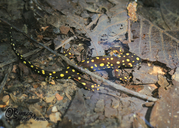|
Neurergus derjugini (Nesterov, 1916)
Kurdistan Newt Subgenus: Neurergus | family: Salamandridae subfamily: Pleurodelinae genus: Neurergus |
 © 2011 Barbod Safaei (1 of 26) |
|
|
|
Description Distribution and Habitat Country distribution from AmphibiaWeb's database: Iran, Islamic Republic of, Iraq
Life History, Abundance, Activity, and Special Behaviors Courtship behavior has been observed in captivity. Initially the male pursues the female from behind or above, seeking to position himself in front of the female and do tail-fanning. The tail tip makes long, large sweeps, about 4 cm away from the male's flank. Fanning occurs in bouts rather than continuously. Turning away from the female, the male walks slowly ahead, with his tail undulating and slightly raised. If the female is responsive to the male's tail-fanning display, she follows. He deposits a spermatophore in front of the female and creeps slowly until he has reached a distance of approximately one body length from the female. Pivoting on one foreleg, he turns 90 degrees and stands perpendicular to the female with his tail folded back and waving slowly, blocking the female's ability to move forward when she has moved about one body length. The female picks up the spermatophore with her cloaca. Males are capable of depositing multiple spermatophores in a single evening (Sparreboom et al. 2000). Eggs are laid singly or in small clusters, on the underside of stones (Sparreboom et al. 2000). Trends and Threats Illegal collection for the pet trade presents a growing threat, and protection under CITES should be considered (Sharifi et al. 2008). It occurs within a legally protected area, the Zagrosian Oak Forest (Sharifi et al. 2008). It is not known whether this species is susceptible to chytridiomycosis (Sharifi et al. 2008). Relation to Humans Possible reasons for amphibian decline General habitat alteration and loss Comments However, the U. S. Fish and Wildlife Service reports that the U. S. is not planning to propose inclusion of N. microspilotus under CITES Appendix II unless "additional information is received" about the population and trade status, or assistance is requested by Iran. The deadline for submitting comments and information to USF&W is September 11, 2009. Species submitted for consideration by the United States and other CITES member countries will be discussed at the CoP15 meeting in Qatar on March 13-25, 2010. Comments pertaining to species proposals should be sent to the Division of Scientific Authority, U.S. Fish and Wildlife Service, 4401 North Fairfax Drive, Room 110, Arlington, VA 22203, or via e-mail at: scientificauthority@fws.gov, or via fax at: 703–358–2276. Comments pertaining to proposed resolutions, decisions, and agenda items should be sent to the Division of Management Authority, U.S. Fish and Wildlife Service, 4401 North Fairfax Drive, Room 212, Arlington, VA 22203, or via e-mail at: CoP15@fws.gov, or via fax at: 703–358–2298. For further information pertaining to species proposals contact: Rosemarie Gnam, Chief, Division of Scientific Authority, phone 703–358– 1708, fax 703–358–2276, e-mail: scientificauthority@fws.gov. For further information pertaining to resolutions, decisions, and agenda items contact: Robert R. Gabel, Chief, Division of Management Authority, phone 703– 358–2095, fax 703–358–2298, e-mail: CoP15@fws.gov.
References
Rastegar-Pouyani, N. (2003). ''Ecology and conservation of the genus Neurergus in the Zagros Mountains, Western Iran.'' FROGLOG, 56. Rastegar-Pouyani, N. (2006). ''Conservation and distribution of Neurergus microspilotus (Caudata: Salamandridae) in the Zagros Mountains, Kermanshah Province, Western Iran.'' Herpetologia Bonnensis II. Proceedings of the 13th Congress of the Societas Europaea Herpetologica. M. Vences, J. Köhler, T. Ziegler, and W. Böhme, eds. Sharifi, M. and Assadian, S. (2004). ''Distribution and conservation status of Neurergus microspilotus (Caudata: Salamandridae) in western Iran.'' Asiatic Herpetological Review, 10, 224-229. Sharifi, M., Shafti, S., Papenfuss, T., Anderson, S., Kuzmin, S., and Rastegar-Pouyani, N. (2008). Neurergus microspilotus. In: IUCN 2009. IUCN Red List of Threatened Species. Version 2009.1. www.iucnredlist.org. Downloaded on 10 August 2009. Sparreboom, M., Steinfartz, S., and Schultschik, G. (2000). ''Courtship behavior of Neurergus (Caudata: Salamandridae).'' Amphibia-Reptilia, 21, 1-11. Originally submitted by: Kellie Whittaker (first posted 2009-07-23) Edited by: Kellie Whittaker, updated Ann T. Chang (2013-08-26) Species Account Citation: AmphibiaWeb 2013 Neurergus derjugini: Kurdistan Newt <https://amphibiaweb.org/species/4260> University of California, Berkeley, CA, USA. Accessed May 23, 2025.
Feedback or comments about this page.
Citation: AmphibiaWeb. 2025. <https://amphibiaweb.org> University of California, Berkeley, CA, USA. Accessed 23 May 2025. AmphibiaWeb's policy on data use. |


 Raffaëlli Account
Raffaëlli Account Map of Life
Map of Life Featured in Amazing Amphibians on 26 August 2013
Featured in Amazing Amphibians on 26 August 2013